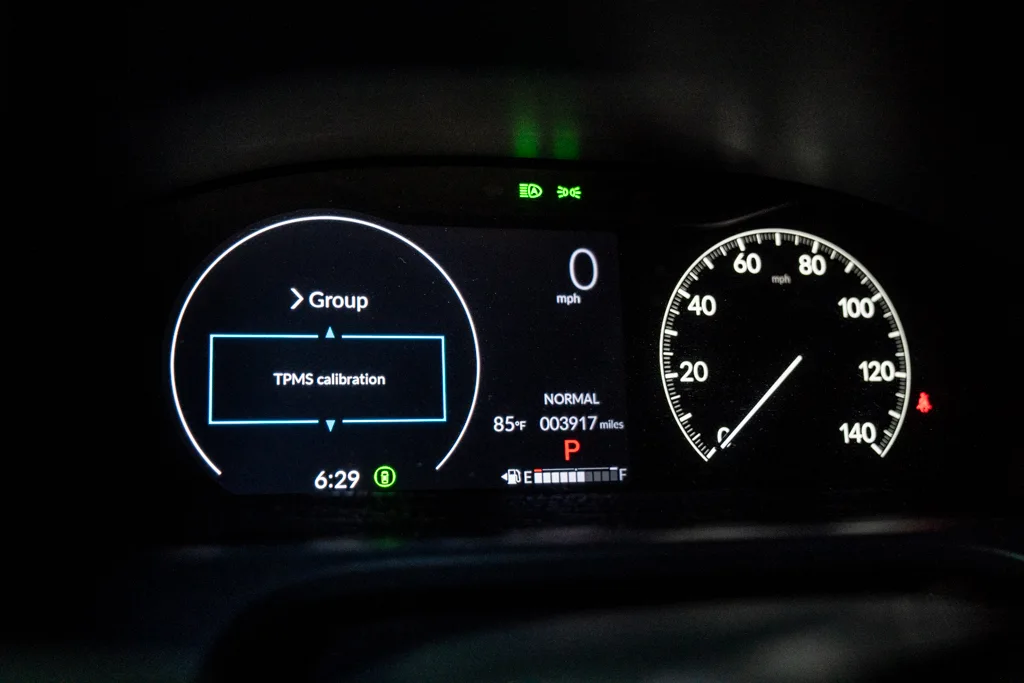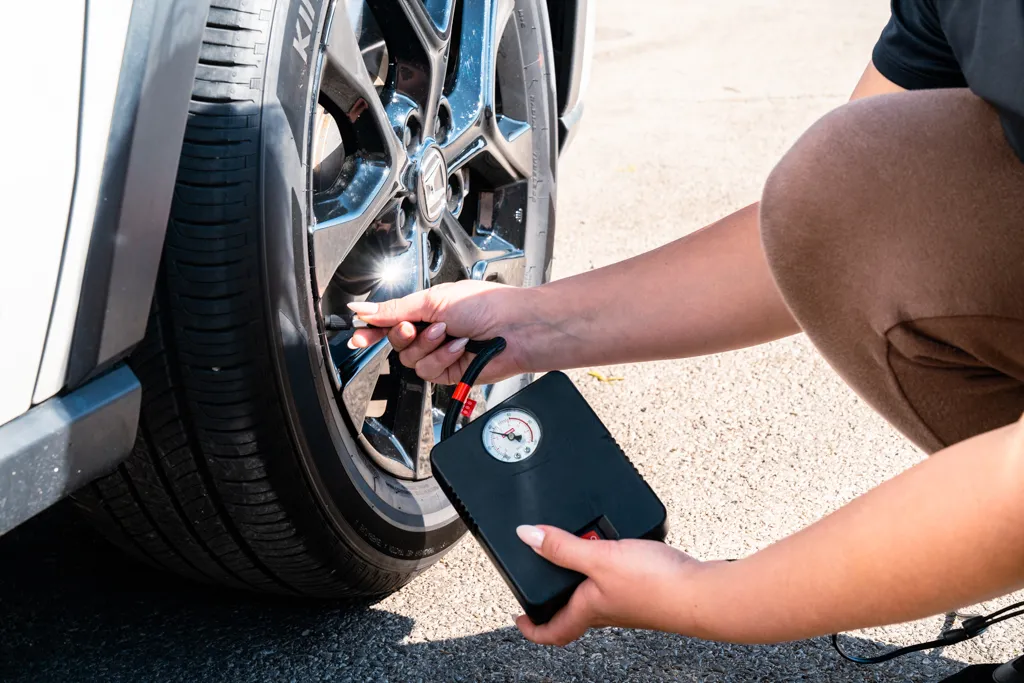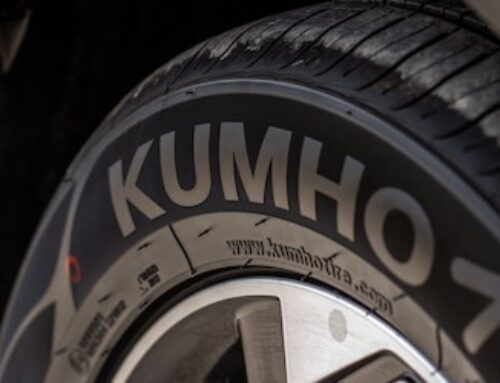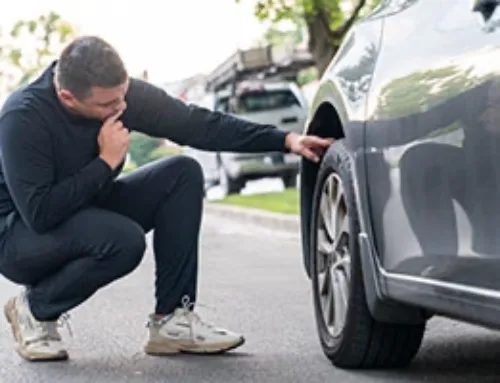Table of Contents
Modern vehicles come with Tire Pressure Monitoring Systems (TPMS) with a tire pressure sensor on each tire. And, occasionally, they need to be calibrated. We’ll explain the importance of your TPMS sensors and how to calibrate them so you always know you’re driving safely with the proper air pressure. Let’s take the two most popular Honda models as an example.

What does my tire pressure monitoring system (TPMS) do?
Keeping your tires at the correct air pressure is important for safe and economical driving. If your tires begin to lose pressure, handling can become unpredictable, and you’re more likely to get into an accident. Plus, low pressure can really affect your fuel economy.
Your tire pressure monitoring system constantly checks your vehicle’s tire pressure, ensuring that all your tires remain at the recommended levels for safe driving. The TPMS uses sensors on each wheel that measure the pressure of your tires. If the pressure drops so that your tire becomes significantly under-inflated, the TPMS tire pressure light on your dashboard will come on, letting you know that you need to fill the tire with air and get it checked for a possible puncture.
This is really important as proper tire pressure is essential for fuel efficiency, tire lifespan, and, most importantly, safety. As it always monitors your air pressure, the tire pressure monitor system helps you avoid unexpected blowouts, uneven tire wear, and unpredictable handling.

Direct and indirect TPMS
There are two types of TPMS systems available—to find out what you have, check your owner’s manual:
- Indirect TPMS systems measure the size of the tire and how fast it’s rotating to work out if it’s deflating or not—if the tire is losing pressure, it will have to rotate faster to keep up. These systems are cheaper and easier to maintain but may be less accurate and have to be reset every time you refill your tires with air or have them rotated or aligned. However, this is a simple procedure you can do yourself.
- Direct TPMS systems actually measure the tire pressure of each tire, so they are more accurate, but if they’re replaced, they need to be re-calibrated. This process needs to be carried out by a mechanic with specialist equipment and can’t be done at home.
How to calibrate your tire pressure sensor
With the two types of TPMS, direct and indirect, you can calibrate your own indirect TPMS system, but if you have a direct TPMS system, you need to go to a specialist tire shop to have them accurately calibrated with a relearn tool. To find out which type of TPMS you have, check your owner’s manual and then read on to learn how to calibrate the tire pressure sensor.

Calibrating a Honda TPMS in 10 steps
Most models of Honda, including the Honda Civic and Honda Accord, have a TPMS you can calibrate yourself after you refill your tires with air, replace a tire, or carry out a tire rotation. To calibrate your TPMS, follow these simple steps:
- When you refill, replace, or rotate your tires, your tire pressure light will come on
- Make sure all your tires are filled accurately to the correct pressure before you begin
- Park your vehicle and keep the power on
- Press the home button. You’ll find this to the left of your steering wheel
- Using the selector wheel choose Settings
- Then select TPMS calibration
- Then using the selector wheel select Calibrate
- After pressing this, Calibration started should appear
- If Calibration fails to start, repeat all the previous steps
- Then you should start driving—the calibration process will occur over a few miles.
Now your tire pressure sensors will be giving accurate readings, so you’ll quickly know if you need to refill or repair any of your tires if they are under-inflated.
Why do I need to calibrate a tire pressure monitoring sensor?
Calibrating your TPMS is important to make sure you get accurate readings so you know if your tire pressure drops too low. There are a few reasons you might have to calibrate it, including refilling your tires with air, having your tires replaced or rotated, and even changes in temperature.
Don’t let the best tire deals & tips roll by!
Sign up for our newsletter
Frequently Asked Questions
How much should it cost to replace a tire pressure sensor?
The cost to replace a single tire pressure sensor ranges from $70 to $200. This price should include labor costs as this is a quick job with the right equipment—it should take around one hour to replace all four sensors in your car. If your TPMS is malfunctioning, it’s important to get a new sensor fitted to ensure your tires are safely filled every time you hit the road.
How do I know if my tire pressure sensor is bad?
The most common sign of a bad tire pressure sensor is when the tire pressure light on your dashboard comes on, and when you check your pressure, it’s in the recommended range. This is when it’s handy to know how to use a tire pressure gauge or how to check tire pressure at a gas station. If the results of these checks come back in the recommended range, this is likely a sign of a malfunctioning sensor.
Some newer cars have a TPMS fault warning light which will come on when the batteries in a sensor die, so check your vehicle’s manual to see which type you have. To pinpoint the issue, it’s always best to consult a professional mechanic or tire technician, as they can perform a thorough inspection, accurately diagnose any TPMS-related problems, and replace a sensor if required.
How do you fix a tire pressure sensor—tire pressure sensor replacement basics?
You should always take your car to a professional mechanic or tire technician to repair or replace your tire pressure sensor. This is because specialist knowledge and tools are required, including, most often, a vehicle manufacturer specific relearn tool. Whether the issue is a dead battery or a damaged or malfunctioning sensor, you’ll almost always have to get replacement sensors, as in most vehicles, they come with built-in batteries. Once the replacement sensor has been installed, the technician will use a relearn device to sync the sensor with your vehicle’s TPMS so you get accurate results in the future.
What tire pressure is too low?
Tire pressures under 20 psi are too low for you to drive on and count as a flat tire, and your TPMS will likely warn you at around 24 – 26 psi. For most vehicles, a psi of 32 to 35 is recommended, but if it drops below 30, you should definitely refill your tire with air. If the pressure is between 20-30 psi, you can drive a short distance to a gas station to refill your tire with air and check it for damage or punctures.









